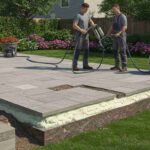Got a barn door that’s letting in too much noise? You’re not alone.
Barn doors look amazing, but they’re pretty terrible at blocking sound.
Those gaps around the edges and that space between the door and wall? Yeah, those are basically VIP passes for noise to walk right through.
But don’t worry! With some simple tricks and materials, you can make that stylish sliding door work harder to keep sound where it belongs.
This guide walks you through exactly what you need to do, starting with quick fixes that won’t cost much, all the way to more serious upgrades if you need serious quiet.
Understanding the Challenges of Soundproofing Barn Doors
The thing about barn doors is they’re built to slide, not seal.
Unlike swing doors that press against a frame when closed, barn doors hang from a track and just sort of… rest near the wall.
This creates gaps on all sides, especially that annoying space between the door and wall.
Plus, many barn doors are made with lightweight materials that sound waves easily pass through.
The track hardware can also vibrate and transfer noise.
Tricky stuff, but definitely fixable!
Inspect the Door and Measure Gaps
First up, let’s figure out exactly where sound is sneaking through.
Grab a flashlight and turn off all the lights.
Have someone hold the flashlight on one side of the closed door while you look from the other side. See light? That’s where sound is getting in too.
Use a measuring tape to check the size of gaps at the bottom, sides, and between the door and wall.
Write these measurements down so you know exactly what materials to buy.
Most barn doors have a 1-2 inch gap at the bottom and about half an inch on the sides and top.
The wall gap might be anywhere from 1-3 inches depending on how your door was installed.
Choose the Right Materials for Soundproofing
Not all soundproofing materials work the same way.
For barn doors, you need stuff that blocks airborne sound and adds weight to the door itself.
Good options include:
- Weatherstripping for edges (rubber or foam)
- Door sweeps or brush seals for the bottom
- Mass-loaded vinyl to add weight to the door
- Acoustic panels or blankets
Doors Los Angeles’ barn doors for sale combine affordability with noise reduction.
Their modern doors are made with an engineered solid wood core featuring medium-density fiberboard, which is more cost-effective than solid wood.
If you’re shopping for a new barn door, this is worth looking into.
For a tight budget, start with weatherstripping and a door sweep, which might cost you $15-30 total.
These small changes can make a big difference right away.
Install Weatherstripping and Door Seals
Let’s tackle those edges.
For a barn door, you’ll need to place weatherstripping along the jamb or wall where the door meets when closed.
Self-adhesive foam tape works great for this. Make sure to:
- Clean the surface with alcohol so the adhesive sticks properly
- Measure and cut strips to fit exactly
- Press firmly as you apply it
- Don’t compress it too much or it won’t work right
For the top edge, stick the weatherstripping to the bottom of the track or to the wall just below the track.
The door should lightly compress the weatherstripping when closed, creating a sound barrier without making the door hard to open or close.
Add a Door Sweep or Brush Seal
That gap at the bottom of your barn door? It’s probably letting in more noise than anywhere else.
Since barn doors slide, you can’t use a regular door sweep that screws into the bottom and touches the floor.
Instead, grab a brush-style sweep made for sliding doors.
These have bristles that touch the floor but still allow the door to slide smoothly.
Installation is pretty simple:
- Measure and cut the sweep to match your door width
- Screw it to the bottom of the door
- Adjust the height so the bristles lightly sweep the floor
If your door slides over carpet, you might need a special low-profile sweep that won’t catch on the fibers.
Use Acoustic Blankets or Curtains
Want a solution that looks nice and blocks sound? Hanging acoustic curtains or blankets can help a lot.
You can install a separate curtain rod above your door and hang sound-blocking curtains that cover the entire door plus those pesky gaps.
When you need serious quiet, pull the curtains closed.
When looks matter more, keep them open.
Moving blankets work too if you’re on a budget, and they only cost about $20-30 each.
Not as pretty, but super effective.
Some people even attach them directly to the door with hook-and-loop fasteners for a cleaner look.
Add Mass and Density to the Barn Door
Sound travels through lightweight doors like they’re barely there.
Adding mass is one of the best ways to block noise.
If you’re handy, you can attach a layer of mass-loaded vinyl to the back of your door.
This dense material blocks sound waves but is still thin enough not to interfere with your door’s operation.
Just make sure your track hardware can handle the extra weight.
Another option is applying a layer of acoustic foam or rubber matting to the back of the door.
This won’t block as much sound as mass-loaded vinyl, but it helps reduce what sound specialists call “sound transmission” through the door material itself.
Address Gaps Between the Wall and the Door
That space between your barn door and the wall is probably your biggest soundproofing challenge.
Here are some clever fixes:
Install a vertical seal strip along the wall edge.
These J-shaped channels create a pocket for your door to slide into when closed.
They’re not super cheap (around $50-100 depending on door height), but they work really well.
For a budget option, try a strip of high-density foam tape along the wall edge.
The door will compress it slightly when closed, creating a better seal.
Some folks install a thin panel on the wall behind where the door rests when closed.
This gives you something solid to seal against with weatherstripping.
Consider Professional Upgrades
If DIY methods aren’t cutting it, some professional options might help:
- Upgrade to a thicker, solid-core barn door specifically designed for sound reduction
- Install a dual-track system with two doors that create an air gap between them
- Add a magnetic seal system designed for barn doors
These solutions cost more ($200-500+) but provide much better results for serious noise problems.
Maintenance Tips
Your soundproofing will only work if you keep it in good shape. Every few months:
- Check weatherstripping for compression or damage
- Make sure brush seals still touch the floor properly
- Test if acoustic panels or blankets are secure
- Tighten any loose hardware that might cause rattling
- Look for new gaps that might have developed
Fix small issues right away before they get worse.
Even the best soundproofing setup needs a little attention now and then.
Conclusion
Soundproofing a barn door takes some work, but the peace and quiet are totally worth it.
Start with the easy fixes like weatherstripping and door sweeps before moving on to bigger projects like adding mass to your door or installing wall seals.
Remember that no barn door will ever block sound completely like a solid wall would.
But with the right techniques, you can reduce noise dramatically while keeping all that sliding door style you love.
Give these methods a try and see what works best for your space.
You might be surprised at how much quieter things get with just a few simple changes!



